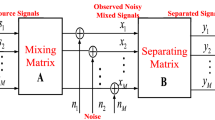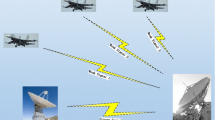Abstract
Aiming at the blind signal-jamming separation (BSJS) in wireless communication environment, we propose a noisy BSJS based on Variational Bayesian Independent Component Analysis algorithm to separate the communication signal from jamming signals and noises. This algorithm takes the Kullback–Leibler divergence between the true post distributions of source signals and the approximate ones as objective function, models sources using mixture of Gaussians, and updates parameters of the model using variational-Bayesian learning method, so as to make the estimated approximate posterior distributions close to the true ones and recover source communication signals finally. The simulation results show that the proposed algorithm is effective for the BSJS in noisy environment.










Similar content being viewed by others
References
Shi, X. (2008). Blind signal processing—Theory and practice. Shanghai: Shanghai Jiao Tong University.
Deng, K., & Jiang, X. (2010). Detection of bio-impedance gastric motility signal based on independent component analysis. Transducer and Microsystem Technologies, 29(6), 124–127.
Nesta, F., & Matassoni, M. (2011). Robust automatic speech recognition through on-line semi blind source extraction. In: CHiME 2011 workshop on machine listening in multisource envirionments.
Lu, Y., Li, Z., & Zeng, Y. (2010). Blind separation of machine fault sources based on cohen class time-frequency analysis. Machine Tool and Hydraulics, 38(7), 134–137.
Wang, E., Zhang, N., & Meng, W. (2009). A concurrent time-frequency and noise-preteatment methodology for blind source separation in an additive white Gaussian noise channel. Journal of Harbin Engineering University, 30(4), 390–394.
Hyvarinen, A. (1999). Fast ICA for noisy data using Gaussian moments. Circuits and Systems. In Proceedings of the 1999 IEEE international symposium, ISCAS’99.
Choudrey, R. A. (2002). Variational methods for Bayesian independent component analysis (Doctoral dissertation, University of Oxford).
Bishop, C. (1995). Neural networks for pattern recognition. Oxford: Clarendon Press.
Valpola, H. (Coordinator) (2003). BLISS IST-1999-14190, Blind source separation and applications: Technical report on Bayesian method. Deliverable D17 report version: Final report preparation date: June 27, 2003.
Caridso, J.-F., & Laheld, B. H. (1996). Equivariant adaptive source separation. IEEE Transactions of Signal Processing, 44(12), 3017–3030.
Hyvarinen, A., & Oja, E. (1997). A fast fixed-point algorithm for independent component analysis. Neural Computation, 9(7), 1483–1492.
Cardoso, J.-F., & Souloumiac, A. (1993). Blind beamforming for non-Gaussian signals. IEE Proceedings F (Rader and, Signal Processing), 140(6), 362–370.
Fu, W., Yang, X., & Liu, N. (2008). Robust algorithm for communication signal blind separation fourth-order-cumulant-based. Journal of Electronics and Information Technology, 30(8), 1853–1856.
Duan, Y, & Zhang, H. (2011). A noise-robust EASI algorithm for noisy blind interference-signal separation. In Proceedings of international conference CyberC-2011. Beijing, pp. 535–539.
Acknowledgments
The authors would like to thank the anonymous reviewers for their constructive comments and suggestions. This work is supported in part by Natural Science Foundation of China under Grant 61001106 and National Program on Key Basic Research Project of China under Grant 2009CB320400.
Author information
Authors and Affiliations
Corresponding author
Appendix A: The Update Equations of the Parameters in VBICA Model
Appendix A: The Update Equations of the Parameters in VBICA Model
In \(p^{\prime }(\mathbf{S}|q)\),
In \(p^{\prime }(q)\),
In (5) and (7),\(\Psi ({\bullet })\) is Digamma function.
In \(p^{\prime }(\mu )\),
In \(p^{\prime }(\beta )\),
In \(p^{\prime }(\mathbf{A})\),
In \(p^{\prime }({\varvec{\Lambda }})\),
Rights and permissions
About this article
Cite this article
Duan, Y., Zhang, H. Noisy Blind Signal-jamming Separation Algorithm Based on VBICA. Wireless Pers Commun 74, 307–324 (2014). https://doi.org/10.1007/s11277-013-1286-6
Published:
Issue Date:
DOI: https://doi.org/10.1007/s11277-013-1286-6




